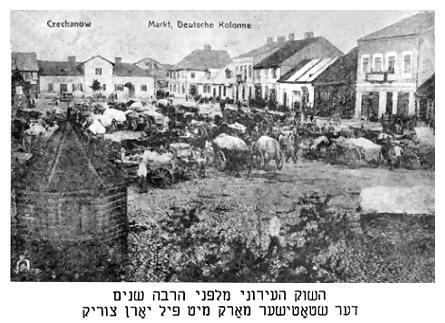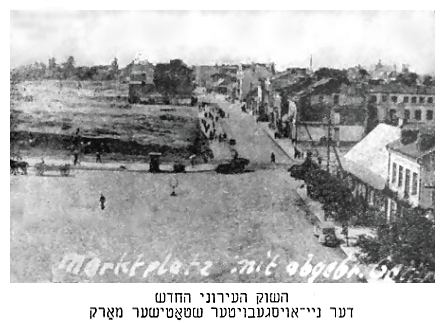

|
[Page 191]
A. Cheder-Years
I was a student in the Talmud Torah. When I arrived there the principal, Reb Avraham Aaron, tested me, pinched my cheek for the “baggage” (learning) that I had brought along -- a sizable amount of Baba Kama off by heart. My first teacher was Reb Mendl, an older Jew. We, the cheder boys, called him “Fania” and other nicknames. He had lots of tzores from us. He did not overlook this, though, and hit us plenty.
We learned Baba Mtzia -- Shanim Akhzin Bhalllit, but our heads were occupied with something else. Through the window we could see the construction of a new house. Each day the skeleton of the roof grows larger and the workers who are laboring there look like dwarfs.
The window of our cheder looks out onto the Jewish cemetery where the Ohel (monument of a great person) of the renowned Ciechanow tzadik Z”L stands. There people come to deposit notes of prayer for God's grace. It is said that before going into the Ohel, one should knock at the door. If not, one might find the tzadik in his tallis and tfillin, and die of fear. (It is told that this actually happened to a student who was a non-believer…)
It is fearful to look out through the window onto the crests of the old half-overgrown and moss-covered gravestones. Still ones eyes are constantly drawn there.
Anyhow, my childish fantasy at that time was full of devils and spirits that scare one in dreams. From the cheder I also remember Rebbe Mordecai Tzinamon -- a middle-aged man with a thick black beard. He told a lot of nice stories.
[Page 192]
In future years I studied in school and in cheder only in the afternoon. This was hard for me so I stopped going to cheder. Mother did not give up, though. She hired a rebbe to come to the house for two hours daily. He would randomly open the Gemara and tell me to “recite”, meanwhile catching a snooze himself, and when he awoke he suddenly started to shout at me, “Nu, carry on! Carry on!”
Still, I did learn some Ivrit (Hebrew) from him (which I later forgot). Yiddish came by itself. In the house we had the works of Sholem Aleichem, Peretz and other Yiddish writers -- the libraries of the older brothers and sisters. My father also liked reading Yiddish books. He was a house-painter. Winter time, when there was no work, he occupied himself with bindery (as the saying goes -- Zibu Malokhes and Vintzig brokhes) “seven trades and few blessings.” Most of the books were Yiddish and as much as I read I could not satisfy my hunger for more.
There was another source of Jewish books: A pair of old folks lived in our courtyard, the old Berke with his old Berkelekhe. They lived from support money from their children in America. In their loft there was a great treasury of all kinds of story books, wonder stories of Shpaler Zaidn, of the Prague Maharal with the Gollom, Firsht Reuveni, Rabbi Akiva, Malka Shabba, stories by the Grimm Brothers and others. These I literally swallowed. The old Berke also liked to have stories read to him because he did not see so well and he did not even want to miss Kutcher's Tzigeinerin of the Letatze Neyes (Latest News).
My mother noted with sorrow how more and more often I skip the davening and tuck in my tzitzis (this she blamed on the school I attended and on the goyishe books, so she sent me to evening courses of the Poele Agudat Yisroel. There one learned Tanach (Proverbs, Ecclesiastes) writing Yiddish, and religious morality. With these evening courses my cheder career ended.
It is worth noting: Up to the present I still remember lines Biz Grinemp palm-land, fun veisn land fun shnai (From the land of green palms, from the land of white snow). In a corner of my heart I still have a feeling for the narrow river in the shtetl with the surrounding lawns, with the ancient castle, with the cement bridge of the “Third of May,” at the long row of acacia and chestnut trees on the Aleike that leads to the railway station …
[Page 193]

|

|
|
|

|
|
|
[Page 194]
blank
|
JewishGen, Inc. makes no representations regarding the accuracy of
the translation. The reader may wish to refer to the original material
for verification.
JewishGen is not responsible for inaccuracies or omissions in the original work and cannot rewrite or edit the text to correct inaccuracies and/or omissions.
Our mission is to produce a translation of the original work and we cannot verify the accuracy of statements or alter facts cited.
 Ciechanow,
Poland
Ciechanow,
Poland  Yizkor Book Project
Yizkor Book Project
 JewishGen Home Page
JewishGen Home Page
Copyright © 1999-2024 by JewishGen, Inc.
Updated 20 June 2003 by LA